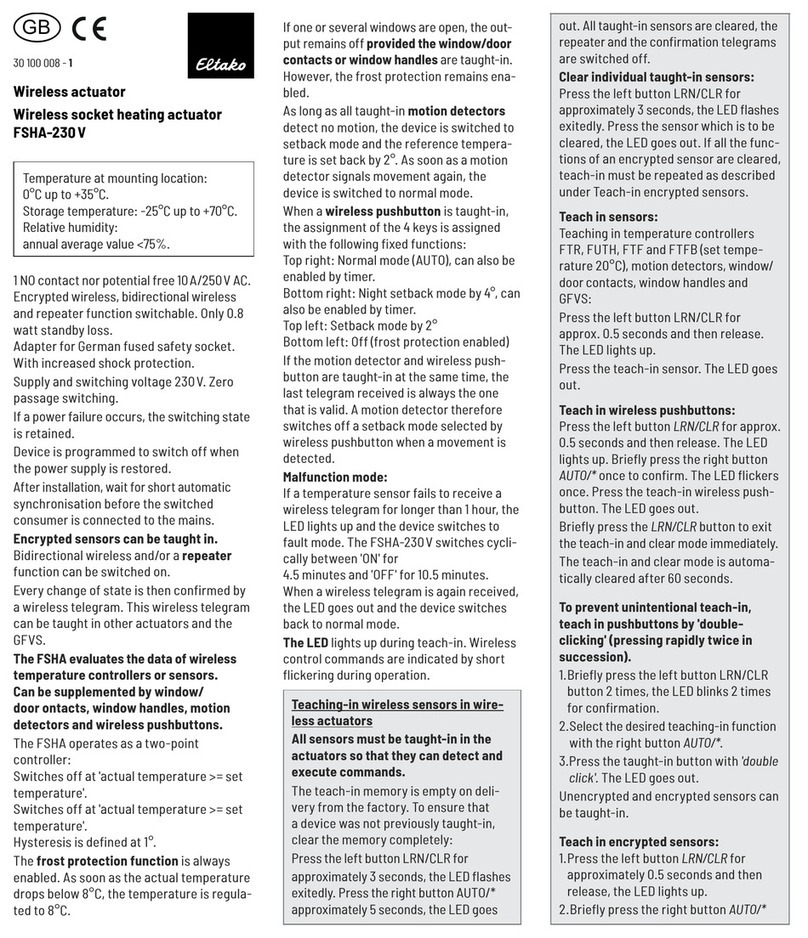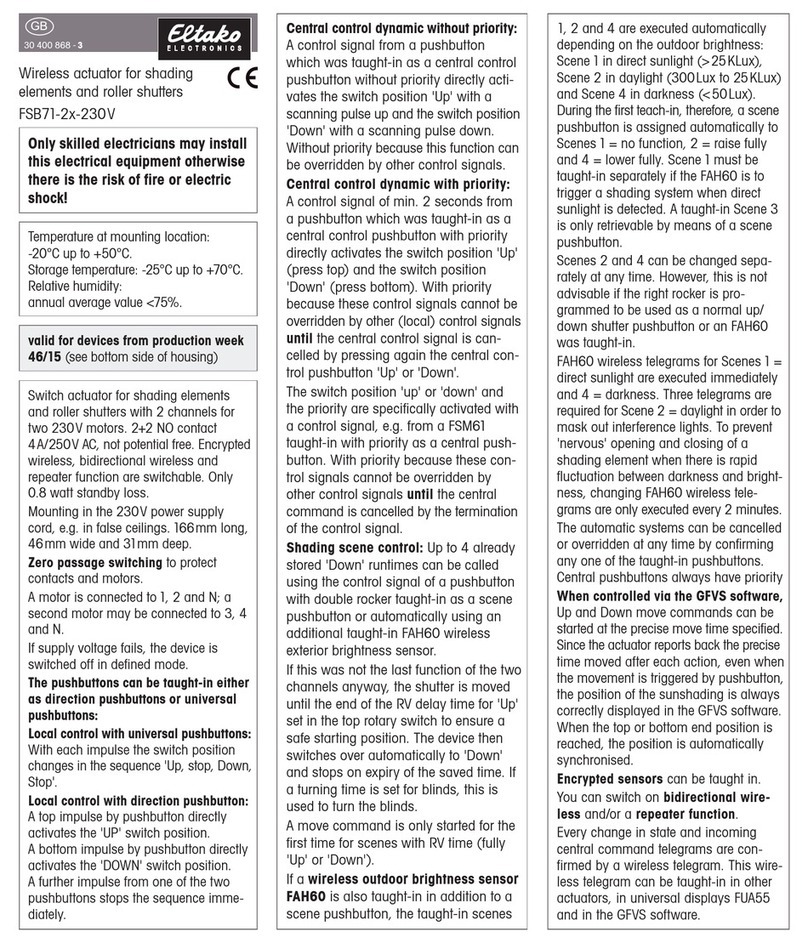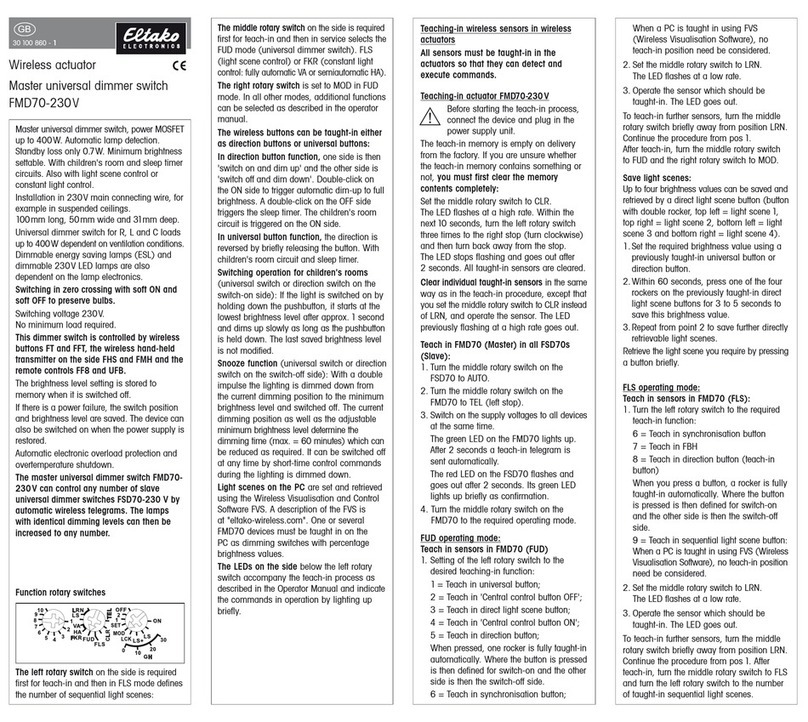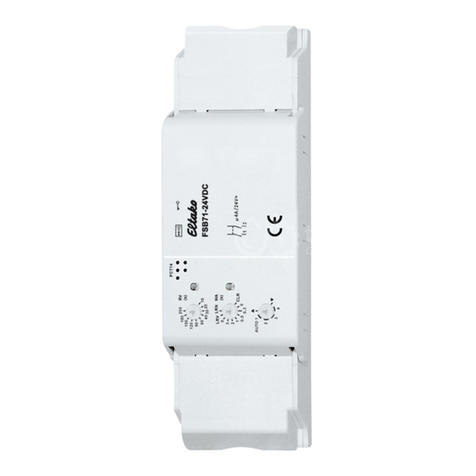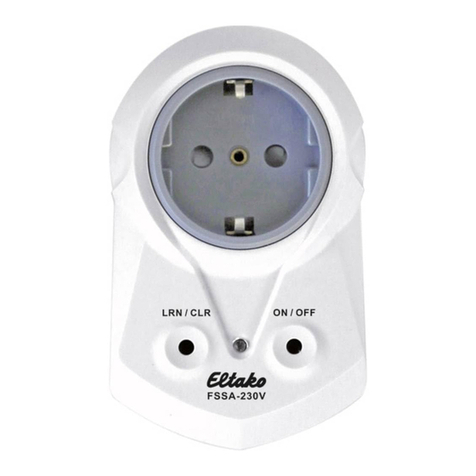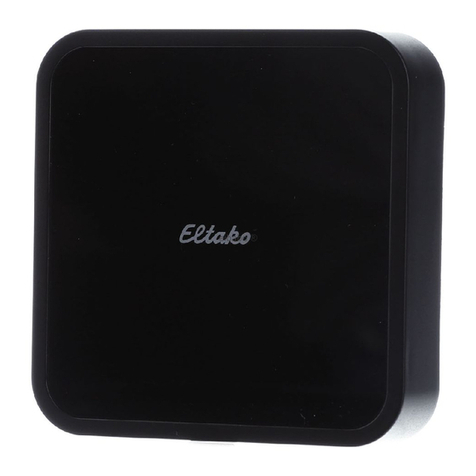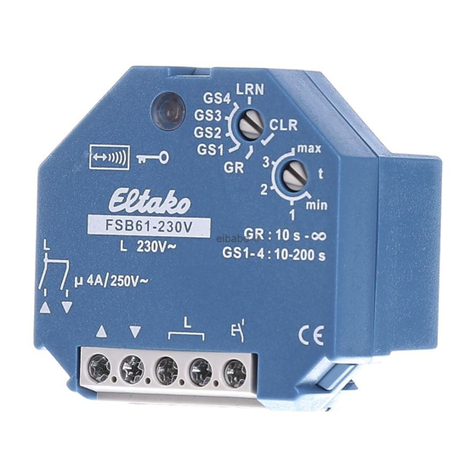
2 NO contact potential free 10A/250V AC,
230V LED lamps up to 400 W, incandescent
lamps up to 2000 watts, off delay with switch
-
off early warning and switchable pushbutton
permanent light. Encrypted wireless, bi-
directional wireless and repeater function
are switchable. Only 0.8 watt standby loss.
For installation.
45mm long, 45 mm wide, 33mm deep.
Supply voltage and control voltage locally 230V.
Zero passage switching.
If a power failure occurs, the switching state
is retained. If a power failure occurs repeatedly,
the device is switched off in a dened sequence.
After installation, wait for short automatic
synchronisation before the switched consumer
is connected to the mains.
In addition to the wireless control input via an
internal antenna, this wireless actuator can
also be controlled locally by a conventional
control pushbutton mounted upstream.
Glow lamp current is not approved.
You can teach in encrypted sensors.
You can switch on bidirectional wireless
and/or a repeater function.
Every change in state and incoming central
command telegrams are then conrmed by a
wireless telegram. This wireless telegram
can be taught-in in other actuators and in a
Smart Home Controller.
Wireless actuator
Impulse switch with integrated relay
function FSR61LN-230V
GB
Temperature at mounting location:
-20°C up to +50°C.
Storage temperature: -25°C up to +70°C.
Relative humidity:
annual average value <75%.
30 200 331 - 9
Only skilled electricians may install this
electrical equipment otherwise there is
the risk of re or electric shock!
valid for devices from production week
09/23 (see bottom side of housing)
Scene control: several FSR61LN can be
switched on or off in a scene by one of the
four control signals of a double-rocker
pushbutton taught-in as scene pushbutton.
Function rotary switches
With the upper rotary switch in the setting
LRN up to 35 wireless pushbuttons can be
assigned therefrom one ore more central
control pushbuttons. In addition wireless
window/door contacts with the function NO
contact or NC contact while the window is open,
wireless brightness sensors and wireless
motion/brightness sensors. The required
function of the impulse switch with integrated
relay function can then be selected:
ER = switching relay
ESV = impulse switch.
Possibly with off delay, then:
+
= ESV with pushbutton
permanent light
+
= ESV with switch-off early
warning
+
= ESV with pushbutton
permanent light and
switch-off early warning
If the permanent light function is switched
on, the function can be activated by pressing
the pushbutton for longer than 1 second. This
function switches off automatically after 2 hours
or by pressing the pushbutton.
If the switch-off early warning is switched
on, the light starts to icker approx. 30 seconds
before time-out. This is repeated three times
at decreasing time intervals.
If both switch-off early warning and push-
button permanent light are switched on,
switch-off early warning is activated before
automatic switch-off of the permanent light.
The function ESV on the bottom rotary switch
sets the off delay from 2 to 120 minutes. In
setting ∞ normal impulse switch function ES
without off delay, without pushbutton
perma-
nent light and without switch-off early warning
.
In setting ER = switching relay of the other
rotary switch, this 2nd rotary switch fulls a
safety and power saving function in the set-
tings except ∞. If the switch-off command is
not recognised, e.g. since the pushbutton is
jammed or it was pressed too quickly, the re-
lay switches off automatically on expiry of a
time adjustable between 2 and 120 seconds.
When a FTK is taught-in, this time function is
turned off.
Rotary switches can be used in function ES and
ESV, the permanent light cannot be activated
by them.
Universal pushbutton as NC contact:
ER function position: The contact opens
when the power supply is applied. When the
pushbutton is released, the contact closes
immediately and when the pushbutton is
pressed, the contact opens immediately.
ESV function position: The contact closes
when the power supply is applied. When the
pushbutton is operated, the contact opens
immediately. When the pushbutton is releas
ed,
the time setting (2 to 120 minutes) starts. On
expiry of the preset time, the contact closes.
In position
∞
the contact closes immediately.
FTK wireless window/door contact (EEP D5-
00-01,
F6-10-00, A5-14-01, -03, -09, -0A): ER
function position: Several FTK are interlinked;
Lower rotary switch to position 2, a monitoring
function is active, i. H. If the cyclical telegram
from the window sensors remains off for 35
minutes, or if the battery voltage falls below
2.5 V, the red LED ashes. Lower rotary switch
to position ∞, the monitoring function is not
active.
Normally open function (e.g. control of ex-
tractor hoods): if a window is opened, the
contact closes. If all windows are closed, the
contact opens. Monitoring function: if at
least one window sensor no longer sends
cyclical telegrams, the contact opens after
35 minutes. Normally open function (e.g.
alarm system): if a window is opened, the
contact closes. If all windows are closed, the
contact opens.
Monitoring function: if at least one window
sensor no longer sends cyclical telegrams, the
contact closes after 35 minutes.
Function NC contact (e.g. climate control):
if a window is opened, the contact opens.
All windows must be closed for the contact to
close.
Monitoring function: if at least one window
sensor no longer sends cyclical telegrams, the
contact opens after 35 minutes.
Twilight pushbutton with taught-in (EEP
A5-06-01, -02, -03) wireless brightness sensor in
function position ESV. The contact closes when
the switch-on threshold is not reached and
opens when the switch-off threshold is exceed-
ed, a hysteresis of 300lux is permanently set. In
time setting 120, the contact opens with a time
delay of 4 minutes when brightness reaches
high enough levels. In time setting
∞
, the con-
tact opens immediately. Pushbutton activation
also remains available.
Vibration sensor (EEP A5-14-05):
function setting ESV: With 'vibration' it is
switched on, with 'not vibration' it is switched
off immediately.
Function setting ER: with 'Vibration' it is
switched on and switched off automatically
after the time adjustable between 2 and
120 seconds has elapsed.
Motion detection with taught-in FBH-slave
(EEP A5-07-01) wireless motion-brightness
sensor or motion sensor FB65B (EEP A5-07-01)
and in ER function position. The device switch-
es on when motion is detected. When no more
motion is detected, the contact opens after the
present release delay time t = 2 up to 255
(FB65B: 120 to 380) seconds (position ∞).
When an FBH-master (EEP A5-08-01)
wireless detector and brightness detector
is taught-in, use the lower rotary switch to
dene the switching threshold at which the
lighting is switched on or off depending on
the brightness (in addition to motion.
A wireless outdoor brightness sensor FHD60SB
(EEP A5-06-01) or a wireless motion / brightness
sensor FBH-Master can be used in the function
setting ER together with FBH-Slave or FB65B so
that movement is only evaluated when it is dark.
If the FHD60SB or FBH master detects bright-
ness, the contact opens immediately.
When teaching-in, the switching threshold is
also taught-in: between break of twilight and
complete darkness.
The LED performs during the teach-in
process according to the operation manual.
It shows wireless control commands by short
ickering during operation.
